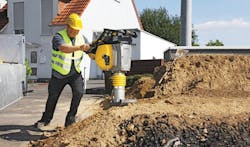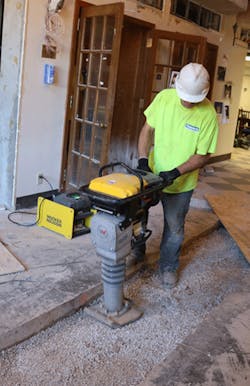After the buried water line is repaired or the new communications cable is installed, the next order of business is putting the surrounding area back to its original, serviceable configuration. Nothing does a better or faster job of compacting material back to its original shape than a ram-type tamper, especially in smaller or confined areas.
Sometimes called a rammer, this piece of light equipment employs repetitive dynamic downward force and the machine’s static weight to consolidate cohesive material so as to increase the density of the soil.
Mechanically compacting the worked material after completing a project is about more than just leaving the work area in as good or better shape than it was when the job started. Improperly filled in trenches will eventually settle, compromising both the load-bearing capacity of the area and the water and frost seepage scheme. That is important because cohesive soils require an adequate amount of moisture to compact well, but the key to good compaction is ensuring the moisture content is consistent. Moisture acts as a lubricant within soil allowing the particles to slide and lock together. Too little moisture results in poor compaction because the particles can’t move past each other to achieve the desired density.
Manufacturers' manuals will spec the lift capacity—the amount of material that can be compacted at one time—for their machines, usually based on making three passes over the trench with the rammer. Although plate compactors that are designed for granular soils have a shallower lift capacity of about 6 inches maximum, vertical rammers will handle around 8 to 12 inches of lift compaction.
Most of the rammers in today’s market are powered by four-cycle gasoline engines. The purpose-built Honda GX100 four-cycle engines used by many rammer manufacturers are engineered to be durable, use straight gasoline, and have low environmental emissions. Importantly, the Honda GX engines allow the rammer to work at sharp angles unlike earlier rammer engines that were limited to a 20-degree operating angle.
Wacker Neuson continues to make rammers with their own two-cycle gas for contractors who prefer a robust machine with a high number of blows per minute and a strong compaction force from a smaller profile unit, while still meeting emission regulations.
Because gasoline-powered engines can lose some strength in higher altitudes, Ammann features its ACR 70 D, a diesel-powered compaction rammer that is the heaviest in the company’s range at 183 pounds. The Yanmar L48 diesel engine suits applications at higher elevations.
Wacker Nueson’s no-emission AS50e rammer is a new battery-powered addition to the rammer marketplace that is finding work in niche construction applications (see sidebar to the right).
Operator productivity, comfort, and safety are inseparable features in upright rammers. Manufacturers battle vibration syndrome—an ergonomic injury causing damage to finger circulation and nerves with symptoms such as numbness, pain, and blanching—with vibration-insulated steering bows, padded grips, and shock absorbers. Less overall vibration also extends the life of the rammer’s components.
Machine controls located on vibration control handles for ease of use and safety shutoffs keep the operator in the best ergonomic position to control the rammer. Self-balancing upright rammers with lower profiles and lower centers of gravity are allowing upright rammers to be maneuvered in and around job-site obstacles with greater ease and accuracy. Adjustable height handles give operators the ability to fit the machine to their reach.
Emphasis on maintenance is highlighted with hour meters and tachometers that track performance. Improved air cleaning systems, some with multiple filters, keep performance-robbing debris out of the rammer’s engine. Auto shutdown features prevent accidental impacts and reduce emissions.
Wacker Neuson AS50e Electric Rammer
When Wacker Neuson brought its AS50e battery-powered rammer to market two years ago, one of its biggest challenges was building a battery that could withstand the impact force required by contractors, says sales engineering manager Fred Paul. But the compactor was the first zero-emission option for contractors, and it opened markets for applications that tolerate absolutely no exhaust.
Preventing closed-environment contamination in an established healthcare or food facility involves tight control of what goes in and comes out of power equipment used onsite, Paul says. Contractors can be required to use only equipment powered by a non-spillable energy source instead of a liquid fuel such as gasoline or diesel. Similarly, exhaust from gas or diesel fuel is also forbidden.
Air quality is monitored and noise levels are evaluated so that a facility’s occupants and operations are only minimally affected during the work. Fluid spills and their resulting cleanup are unacceptable.
Contractors who specialize in these applications are familiar with construction-approval processes that require the contractor’s assurance that all powered equipment and procedures stay within contamination guidelines set by regulating bodies such as the American Society for Health Care Engineering of the American Hospital Association or the FDA’s Food Current Good Manufacturing Practices.
On these sensitive job locations, using a battery powered rammer completely eliminates any air or fluid contamination risks, while the unit’s quieter asynchronous electric motor adds fewer decibels to the already noisy compaction process.
Wacker Neuson engineers knew, however, that productivity could not be compromised at the cost of cleanliness. They took up the challenge to design a battery that would withstand the rigors of being “dropped” 680 times per minute and deliver the power expected by operators.
The resulting battery pack features a state-of-the art lithium-ion battery in a rugged housing with an internal steel protective cage, along with an active cooling system. The cathode metal oxide configuration gives the battery the required performance and durability. Paul says the metal oxide mix also significantly increases the battery’s run time and number of charging cycles compared to earlier generations of lithium ion batteries. The AS50e’s design and performance is consistent with other Wacker Neuson 50-series gas-powered rammers, he says.


